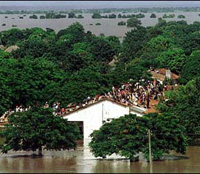Rescuers save Mozambican villagers stranded by floodwaters in dugouts
In dugout canoes, motorboats and a U.N. helicopter, relief workers rescued stranded villagers from rising floodwaters of the Zambezi River on Wednesday.

The flooding claimed another 10 lives this week, according to Mozambique state radio and TV reports, raising the national toll to 40 dead. Throughout the region, more than 100 people have died.
Since late December, torrential rains have swamped a swath of southern Africa from Angola on the Atlantic Ocean in the west to Mozambique along the Indian Ocean.
Adding to the urgency of rescue efforts, more rain is forecast to sweep the region and the floodgates of dams that are in danger of bursting need to be opened.
International agencies are appealing for emergency aid.
Thousands of hectares of crops have been destroyed, roads have been washed out, bridges damaged and utility polls uprooted.
Despite the obvious dangers and memories of floods that killed 800 Mozambicans six years ago, some are resisting evacuation orders, even as waters submerge maize fields within sight of their huts and the only visible remains of neighbors' homes are the tops of thatched roofs peaking above newly formed lakes.
"No chickens, no goats!" a U.N. official declared firmly, relaying instructions for evacuation as the white helicopter swooped down and landed in front of the water pump on Cocorico island, where about 120 people were reported trapped by rising waters.
Officials in Mozambique already have evacuated more than 80,600 people half of the total number under threat, according to Paulo Zucula, head of the national disaster relief agency. Most are subsistence farmers who grow maize and rice and own a few cattle or goats, reports AP.
He expects the flooding to get worse than it did in 2001, when floods hit at the end of the rainy season. With six weeks and more rain to go, water levels are rising up to 7.3 meters (24 feet) around Caia, the farming center serving as the headquarters for the relief effort and itself threatened by rising waters.
Just outside town, two boys paddle a dugout canoe through what was a maize field.
"This is going to be worse because there's going to be more water and it's going to be longer on the ground," Zucula said.
But he expected many fewer casualties because of an early warning system and preparedness set in place since the last deadly floods. "We knew in October that we were going to have problems and started on the ground in early December," he said.
Subscribe to Pravda.Ru Telegram channel, Facebook, RSS!




